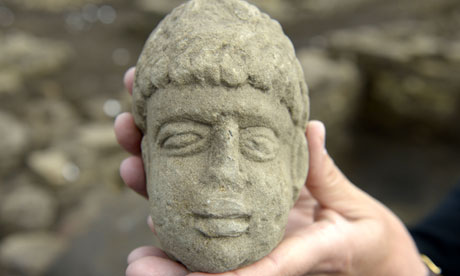A former Bishop’s Stortford College student has made an astounding archaeological discovery – unearthing a 1,800-year-old carved stone head of what is believed to be a Roman god in an ancient rubbish dump.
Alex Kirton, 19, who has just completed the first year of a degree at Durham University was three weeks into a dig at Binchester Roman Fort, near Bishop Auckland, in County Durham when he found the artefact, which measures about 20cm by 10cm, buried in refuse within what was probably a bath house.
Alex, who completed A-levels in history, geograp hy, biology and chemistry at Bishop's Stortford College where dad John is a teacher, before beginning his course in archaeology and ancient civilisations said: "Well, it was a pretty special moment, as you can guess.”
hy, biology and chemistry at Bishop's Stortford College where dad John is a teacher, before beginning his course in archaeology and ancient civilisations said: "Well, it was a pretty special moment, as you can guess.”
"It was a once in a lifetime find."
The sandstone head, which dates from the 2nd or 3rd century AD, has been likened to the Celtic deity Antenociticus, thought to have been worshipped as a source of inspiration and intercession in military affairs.
A similar sandstone head, complete with an inscription identifying it as Antenociticus, was found at Benwell, in Newcastle upon Tyne, in 1862.
Alex, who is a former member of Stortford Hockey Club and a keen scuba diver, said: "It was fairly obvious I had found something. I was taking out a lot of soil and I uncovered the back of the head and I could see the working of the hair. It rolled out, face up, and the features were very easily distinguishable. I had no idea who it was, but I knew that it was evidently someone or something special."
His find has inspired Alex to consider a career as an archaeologist.
Dr David Petts, lecturer in archaeology at Durham University, said: "We found the Binchester head close to where a small Roman altar was found two years ago. We think it may have been associated with a small shrine in the bath house and dumped after the building fell out of use, probably in the 4th century AD.
“It is probably the head of a Roman god – we can’t be sure of his name, but it does have similarities to the head of Antenociticus found at Benwell in the 19th century.
“We may never know the true identity of this new head, but we are continuing to explore the building from which  it came to help us improve our understanding of late Roman life at Binchester and the Roman Empire’s northern frontier in Northern England."
it came to help us improve our understanding of late Roman life at Binchester and the Roman Empire’s northern frontier in Northern England."
“Antenociticus is one of a number of gods known only from the northern frontier, a region which seems to have had a number of its own deities.“It's also an excellent insight into the life and beliefs of the civilians living close to the Roman fort. The style is a combination of classical Roman art and more regional Romano-British traditions. It shows the population of the settlement taking classical artistic traditions and making them their own.”
Dr David Mason, principal archaeologist with the site’s owner, Durham County Council, said: “The head is a welcome addition to the collection of sculpture and inscriptions from Binchester. Previous religious dedications from the site feature deities from the classical pantheon of gods and goddesses such as the supreme god Jupiter and those associated with healing and good health such as Aesculapius, Salus and Hygeia.
“This one however appears to represent a local Romano-Celtic god of the type frequently found in the frontier regions of the Empire and probably representing the conflation of a classical deity with its local equivalent. The similarity with the head of Antenociticus is notable, but this could be a deity local to Binchester.”
The Binchester head is African in appearance, but Dr Petts, who is also associate director of Durham University’s Institute of Medieval and Early Modern Studies, said experts were unsure whether these features were deliberate or coincidental.
He explained: “This is something we need to consider deeply. If it is an image of an African, it could be extremely important, although this identification is not certain.”
Dr Mason added: “The African style comparison may be misleading as the form is typical of that produced by local craftsmen in the frontier region.”
The find was made as part of a five-year project at Binchester Roman Fort which is shedding new light on the twilight years of the Roman Empire.
Each summer, undergraduate archaeology students like Alex from Durham and the United States are joined by volunteer members of the public to painstakingly reveal more fascinating details from Binchester’s past.
His find has inspired Alex to consider a career as an archaeologist.